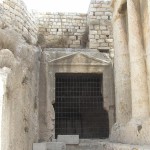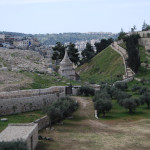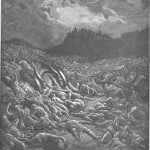Jerusalem. Tombs of the Kidron Valley. Part two
King Jehoshaphat. Engraving from the collection of biographies Promptuarii Iconum Insigniorum (1553)
Behind Absalom’s tomb there is a cave, hewn in the rock, dating back to the same period as the tomb of Absalom. The entrance to the tomb is decorated with a beautifully chiselled portico. According to tradition, this cave is the burial site of King Jehoshaphat , although in the Bible it says, “Then Jehoshaphat rested with his ancestors and was buried with them in the city of David his father.” (1 Kings 22:50). Perhaps, this tradition came into being because this part of the Kidron Valley from the days of old was called the valley of Jehoshaphat, and it is related to the prophesy of Joel, “I will also gather all nations, and will bring them down into the valley of Jehoshaphat, and will plead with them there for My people and for My heritage Israel, whom they have scattered among the nations, and parted My land.” (Joel 3:2). The name Jehoshaphat in Hebrew means the Lord Judge. Therefore, the traditions of all three religions: Judaism, Christianity, and Islam agree that this place at the end of days will be the site of the Last Judgement.
Jehoshaphat was the fourth king of Judah, the son of king Asa and his wife Azubah, who ascended to the throne in Jerusalem at the age of thirty and reigned for twenty five years, the contemporary of three kings of Israel – Ahab, Ahaziah, and Jehoram.
King Jehoshaphat was a worthy imitator of the works of his father, and became known for his righteousness, wisdom, and diligence. He fervently kept his ancestors’ faithfulness to God and fought with idolatry – destroyed pagan idols, high places, and Asherah poles in his kingdom, and “the remnant of the sodomites, which remained in the days of his father Asa, he took out of the land.” In the third year of his reign, Jehoshaphat sent out a group of his officials, priests, and Levites, and “they taught throughout Judah, taking with them the Book of the Law of the Lord; they went around to all the towns of Judah and taught the people.” For these righteous deeds, “the Lord established the kingdom under his control; and all Judah brought gifts to Jehoshaphat, so that he had great wealth and honour.”
Jehoshaphat paid great attention to enforcing justice in his country. “He appointed judges in the land, in each of the fortified cities of Judah. He told them, “Consider carefully what you do, because you are not judging for mere mortals but for the Lord, who is with you whenever you give a verdict. Now let the fear of the Lord be on you. Judge carefully, for with the Lord our God there is no injustice or partiality or bribery.” In Jerusalem also, Jehoshaphat appointed some of the Levites, priests and heads of Israelite families to administer the law of the Lord and to settle disputes… He gave them these orders: “You must serve faithfully and wholeheartedly in the fear of the Lord. In every case that comes before you from your people who live in the cities—whether bloodshed or other concerns of the law, commands, decrees or regulations—you are to warn them not to sin against the Lord; otherwise His wrath will come on you and your people. Do this, and you will not sin.” The justice in religious affairs Jehoshaphat commissioned to high priest Amariah, and in secular, civil matters – to prince Zebadiah.
Jehoshaphat considered one of his main tasks to strengthen the defence capability of the Kingdom of Judah. Right after his enthronement, “He stationed troops in all the fortified cities of Judah and put garrisons in Judah and in the towns of Ephraim that his father Asa had captured.” Providing everything needful for his quite significant army, Jehoshaphat “built forts and store cities in Judah,” and he “built a fleet of trading ships to go to Ophir for gold” (according to another version – to go to Tarshish, an ancient city on the coast of Spain), but these ships were wrecked by a storm. Jehoshaphat’s efforts did not go in vain. “The fear of the Lord fell on all the kingdoms of the lands surrounding Judah, so that they did not go to war against Jehoshaphat. Some Philistines brought Jehoshaphat gifts and silver as tribute, and the Arabs brought him flocks: seven thousand seven hundred rams and seven thousand seven hundred goats.”
While preparing for war, actually Jehoshaphat did not seek it. Unlike his father Asa, who was at war with the kingdom of Israel, Jehoshaphat not only made peace with the Israelites, but established family relationships with the king of Israel – married his eldest son Jehoram to Ahab’s daughter Athaliah. Jehoshaphat even tried to help Ahab to take Ramoth Gilead from Syrians, fighting for which Ahab was killed; and Jehoshaphat himself, mistaken by Syrians for the king of Israel they hated so much, barely escaped. Together with Jehoram, Ahab’s son, Jehoshaphat participated in a punitive expedition against the Moabite king Mesha, who “seceded” from Israelites after Ahab’s death. Jehoshaphat’s cooperation with the wicked kings of Israel even provoked the wrath of God, concerning which Jehu the seer informed the king of Judah; but this sin of Jehoshaphat was forgiven for his uncompromising struggle against the idol worship.
When the combined forces of the Ammonites, Moabites, and men from Mount Seir came to wage war against the kingdom of Judah, “Alarmed, Jehoshaphat resolved to inquire of the Lord, and he proclaimed a fast for all Judah,” and then he gathered his subjects in the Jerusalem Temple to seek help from the God of their fathers. During the gathering, the Spirit of the Lord came on Levite Jahaziel, and he declared that they should not be afraid of the enemy, for God would grant the Jews victory over them without fighting a battle. In the morning, Jehoshaphat led his army against the enemy, and in front of it there were the Levite singers, who praised their God. “As they began to sing and praise, the Lord caused strife between the men of Ammon and Moab and Mount Seir who were invading Judah, and they were defeated. The Ammonites and Moabites rose up against the men from Mount Seir to destroy and annihilate them. After they finished slaughtering the men from Seir, they helped to destroy one another. When the men of Judah came to the place that overlooks the desert and looked toward the vast army, they saw only dead bodies lying on the ground; no one had escaped.” As they went down to the battlefield, the Jews “found a great amount of equipment and clothing and also articles of value—more than they could take away.” After this miraculous victory, no one dared to wage war against Jehoshaphat.
Jehoshaphat had seven sons. The eldest son among them, Jehoram was proclaimed the heir, and to his brothers Jehoshaphat “had given many gifts of silver and gold and articles of value, as well as fortified cities in Judah.” After Jehoshaphat’s death, Jehoram took the throne and “put all his brothers to the sword.”
This article uses the materials from the book by A. P. Kondrashov Who is who in the Bible: Popular Encyclopaedic Dictionary, RIPOLL classic, 2004.



